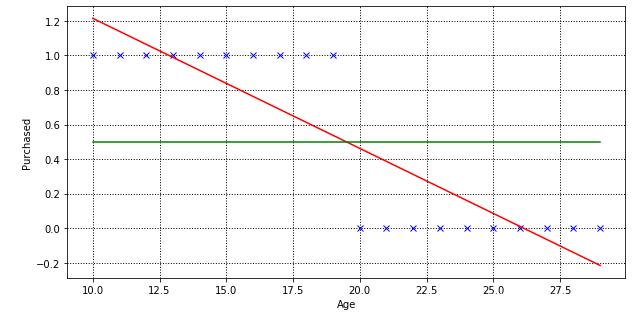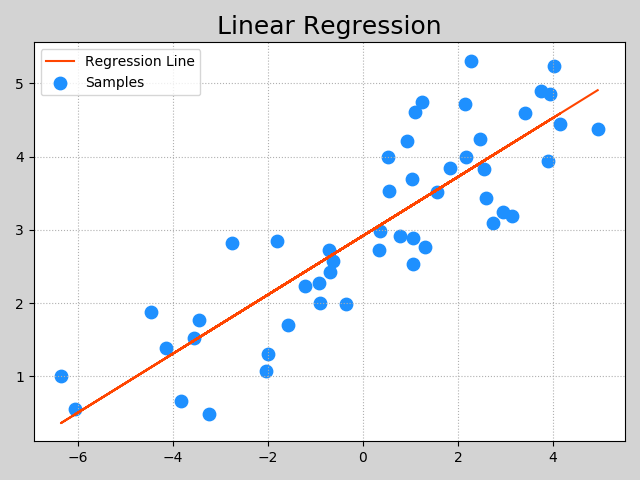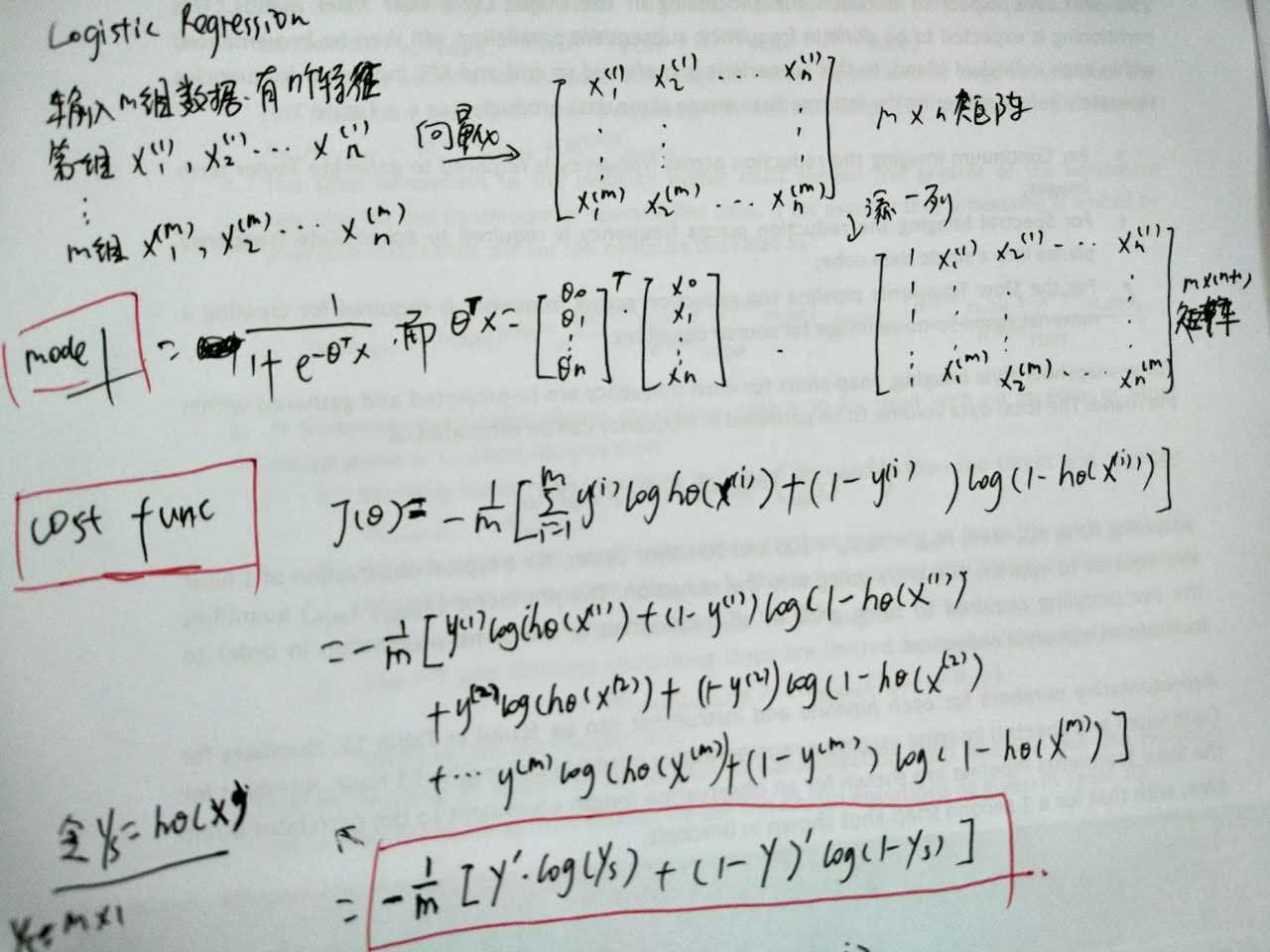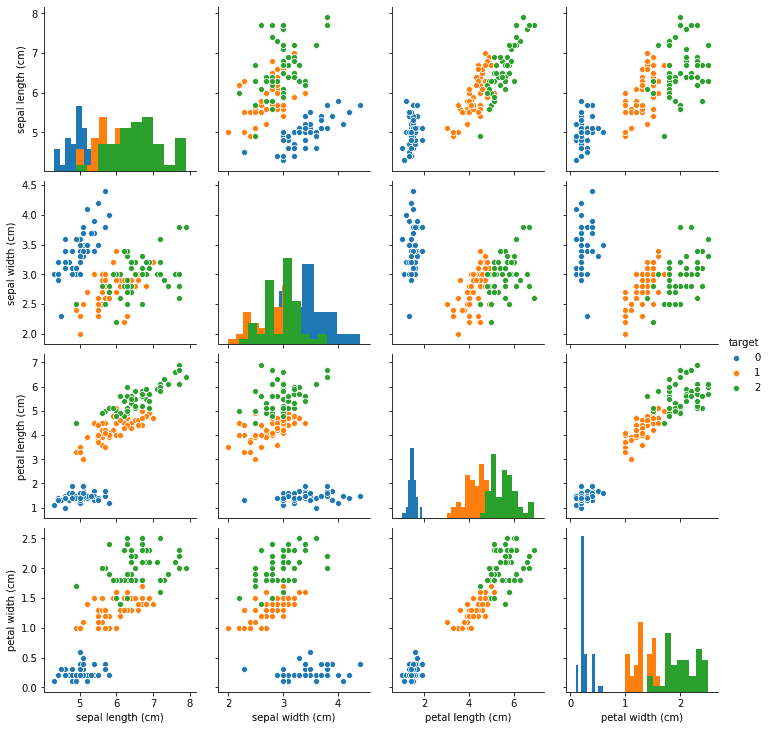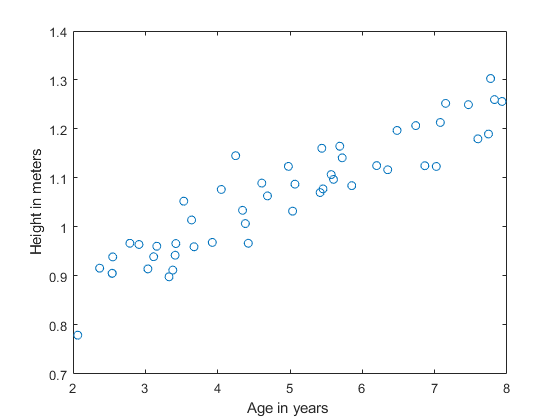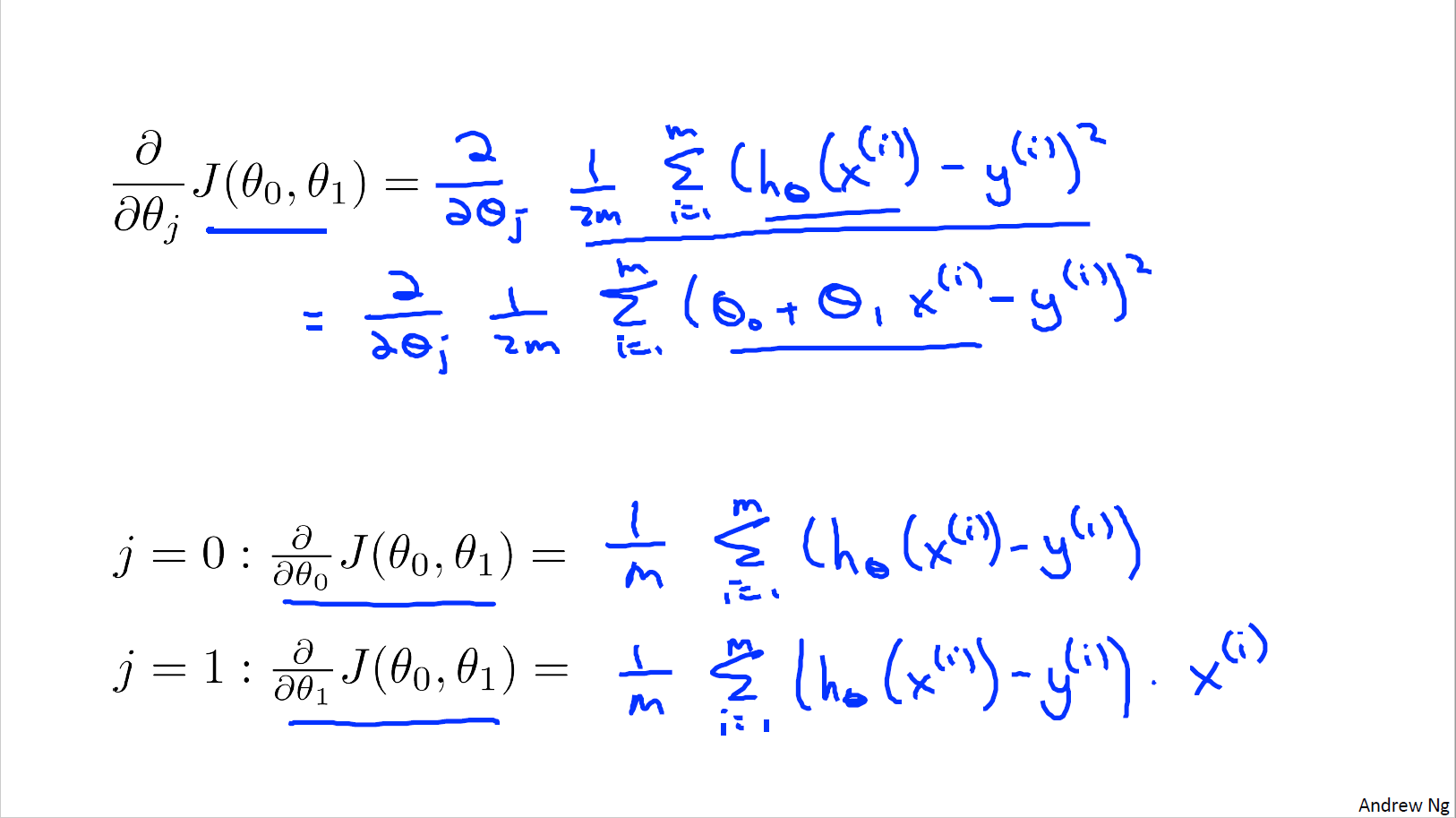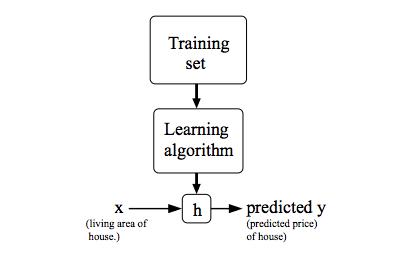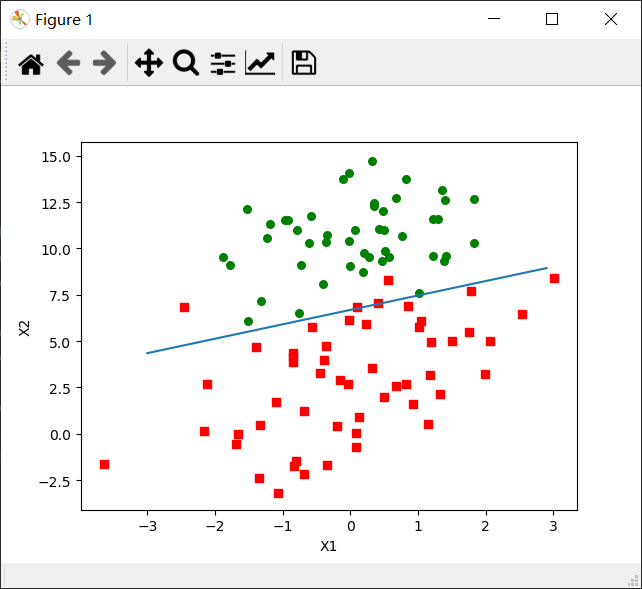Machine Learning(Andrew Ng)ex1.linear regression
Linear Regression
import tensorflow as tf
import pandas as pd
import matplotlib.pyplot as plt
import numpy as np
from mpl_toolkits.mplot3d import Axes3D
path='ex1data1.txt'
data=pd.read_csv(path,header=None,names=['Population','Profit'])
data.head()
| Population | Profit | |
|---|---|---|
| 0 | 6.1101 | 17.5920 |
| 1 | 5.5277 | 9.1302 |
| 2 | 8.5186 | 13.6620 |
| 3 | 7.0032 | 11.8540 |
| 4 | 5.8598 | 6.8233 |
data.plot(kind='scatter',x='Population',y='Profit',figsize=(12,8))
plt.show()

def computeCost(X, y, theta):
J= np.sum(np.power(((X * theta.T) - y), 2))*(1/(2 * len(X)))
return J
data.insert(0, 'Ones', 1)
cols = data.shape[1]
X = data.iloc[:,0:cols-1]
y = data.iloc[:,cols-1:cols]
X.head()
| Ones | Population | |
|---|---|---|
| 0 | 1 | 6.1101 |
| 1 | 1 | 5.5277 |
| 2 | 1 | 8.5186 |
| 3 | 1 | 7.0032 |
| 4 | 1 | 5.8598 |
y.head()
| Profit | |
|---|---|
| 0 | 17.5920 |
| 1 | 9.1302 |
| 2 | 13.6620 |
| 3 | 11.8540 |
| 4 | 6.8233 |
X = np.matrix(X.values)
y = np.matrix(y.values)
theta = np.matrix(np.array([0,0]))
theta
matrix([[0, 0]])
computeCost(X,y,theta)
32.072733877455676
theta.shape[1]
2
def gradientDescent(x,y,theta,alpha,iterations):
temp=np.matrix(np.zeros(theta.shape[1]))#單變量x只有一個
parameters=int(theta.shape[1])#theta的個數,ravel函數轉化成一列數組
cost=[]
#theta_0_history=[]
#teeta_1_history=[]
for i in range(iterations):
error=(x*theta.T)-y
for j in range(parameters):
term=np.multiply(error,x[:,j])
temp[0,j]=theta[0,j]-((alpha/len(x))*np.sum(term))
theta=temp
cost.append(computeCost(x,y,theta))
#theta_0_history.append(temp[0,0])
#theta_1_history.append(temp[0,1])
return theta,cost
alpha=0.01
iters=1000
theta_new,cost=gradientDescent(X,y,theta,alpha,iters)
computeCost(X,y,theta_new)
4.515955503078912
x=np.linspace(data.Population.min(),data.Population.max(),100)
f=theta_new[0,0]+theta_new[0,1]*x
fig,ax=plt.subplots(figsize=(12,8))
ax.plot(x,f,'y',label='Prediction')
ax.scatter(data.Population,data.Profit,marker='^',label='Trainning Data')
ax.set_xlabel('Population')
ax.set_ylabel('Profit')
ax.set_title('Predicted Profit vs. Population Size')
plt.show()

X
matrix([[ 1. , 6.1101],
[ 1. , 5.5277],
[ 1. , 8.5186],
[ 1. , 7.0032],
[ 1. , 5.8598],
[ 1. , 8.3829],
[ 1. , 7.4764],
[ 1. , 8.5781],
[ 1. , 6.4862],
[ 1. , 5.0546],
[ 1. , 5.7107],
[ 1. , 14.164 ],
[ 1. , 5.734 ],
[ 1. , 8.4084],
[ 1. , 5.6407],
[ 1. , 5.3794],
[ 1. , 6.3654],
[ 1. , 5.1301],
[ 1. , 6.4296],
[ 1. , 7.0708],
[ 1. , 6.1891],
[ 1. , 20.27 ],
[ 1. , 5.4901],
[ 1. , 6.3261],
[ 1. , 5.5649],
[ 1. , 18.945 ],
[ 1. , 12.828 ],
[ 1. , 10.957 ],
[ 1. , 13.176 ],
[ 1. , 22.203 ],
[ 1. , 5.2524],
[ 1. , 6.5894],
[ 1. , 9.2482],
[ 1. , 5.8918],
[ 1. , 8.2111],
[ 1. , 7.9334],
[ 1. , 8.0959],
[ 1. , 5.6063],
[ 1. , 12.836 ],
[ 1. , 6.3534],
[ 1. , 5.4069],
[ 1. , 6.8825],
[ 1. , 11.708 ],
[ 1. , 5.7737],
[ 1. , 7.8247],
[ 1. , 7.0931],
[ 1. , 5.0702],
[ 1. , 5.8014],
[ 1. , 11.7 ],
[ 1. , 5.5416],
[ 1. , 7.5402],
[ 1. , 5.3077],
[ 1. , 7.4239],
[ 1. , 7.6031],
[ 1. , 6.3328],
[ 1. , 6.3589],
[ 1. , 6.2742],
[ 1. , 5.6397],
[ 1. , 9.3102],
[ 1. , 9.4536],
[ 1. , 8.8254],
[ 1. , 5.1793],
[ 1. , 21.279 ],
[ 1. , 14.908 ],
[ 1. , 18.959 ],
[ 1. , 7.2182],
[ 1. , 8.2951],
[ 1. , 10.236 ],
[ 1. , 5.4994],
[ 1. , 20.341 ],
[ 1. , 10.136 ],
[ 1. , 7.3345],
[ 1. , 6.0062],
[ 1. , 7.2259],
[ 1. , 5.0269],
[ 1. , 6.5479],
[ 1. , 7.5386],
[ 1. , 5.0365],
[ 1. , 10.274 ],
[ 1. , 5.1077],
[ 1. , 5.7292],
[ 1. , 5.1884],
[ 1. , 6.3557],
[ 1. , 9.7687],
[ 1. , 6.5159],
[ 1. , 8.5172],
[ 1. , 9.1802],
[ 1. , 6.002 ],
[ 1. , 5.5204],
[ 1. , 5.0594],
[ 1. , 5.7077],
[ 1. , 7.6366],
[ 1. , 5.8707],
[ 1. , 5.3054],
[ 1. , 8.2934],
[ 1. , 13.394 ],
[ 1. , 5.4369]])
fig=plt.figure(dpi=500)
ax = Axes3D(fig)
theta_0=np.linspace(-10,10,100)
theta_1=np.linspace(-1,4,100)
cos=np.arange(10000).reshape(100,100)
#t=np.matrix([theta_0,theta_1])
theta_0,theta_1=np.meshgrid(theta_0,theta_1)
for i in range(100):
for j in range(100):
t=np.matrix([theta_0[i],theta_1[j]])
cos[i,j]=computeCost(X,y,t.T)
ax.plot_surface(theta_0,theta_1,cos,rstride=1,cstride=1,cmap=plt.get_cmap('rainbow'))
plt.show()

fig, ax = plt.subplots(figsize=(12,8))
ax.plot(np.arange(iters),cost,'r')
ax.set_ylabel('Cost')
ax.set_title('Error vs. Training Epoch')
plt.show()

Linear regression with multiple variables
path = 'ex1data2.txt'
data2 = pd.read_csv(path, header=None, names=['Size', 'Bedrooms', 'Price'])
data2.head()
| Size | Bedrooms | Price | |
|---|---|---|---|
| 0 | 2104 | 3 | 399900 |
| 1 | 1600 | 3 | 329900 |
| 2 | 2400 | 3 | 369000 |
| 3 | 1416 | 2 | 232000 |
| 4 | 3000 | 4 | 539900 |
data2 = (data2 - data2.mean()) / data2.std()
data2.head()
| Size | Bedrooms | Price | |
|---|---|---|---|
| 0 | 0.130010 | -0.223675 | 0.475747 |
| 1 | -0.504190 | -0.223675 | -0.084074 |
| 2 | 0.502476 | -0.223675 | 0.228626 |
| 3 | -0.735723 | -1.537767 | -0.867025 |
| 4 | 1.257476 | 1.090417 | 1.595389 |
data2.insert(0, 'Ones', 1)
data2.head()
| Ones | Size | Bedrooms | Price | |
|---|---|---|---|---|
| 0 | 1 | 0.130010 | -0.223675 | 0.475747 |
| 1 | 1 | -0.504190 | -0.223675 | -0.084074 |
| 2 | 1 | 0.502476 | -0.223675 | 0.228626 |
| 3 | 1 | -0.735723 | -1.537767 | -0.867025 |
| 4 | 1 | 1.257476 | 1.090417 | 1.595389 |
cols = data2.shape[1]
X2 = data2.iloc[:,0:cols-1]
y2 = data2.iloc[:,cols-1:cols]
# convert to matrices and initialize theta
X2 = np.matrix(X2.values)
y2 = np.matrix(y2.values)
theta2 = np.matrix(np.array([0,0,0]))
print(X2)
# perform linear regression on the data set
g2, cost2 = gradientDescent(X2, y2, theta2, alpha, iters)
# get the cost (error) of the model
computeCost(X2, y2, g2)
[[ 1.00000000e+00 1.30009869e-01 -2.23675187e-01]
[ 1.00000000e+00 -5.04189838e-01 -2.23675187e-01]
[ 1.00000000e+00 5.02476364e-01 -2.23675187e-01]
[ 1.00000000e+00 -7.35723065e-01 -1.53776691e+00]
[ 1.00000000e+00 1.25747602e+00 1.09041654e+00]
[ 1.00000000e+00 -1.97317285e-02 1.09041654e+00]
[ 1.00000000e+00 -5.87239800e-01 -2.23675187e-01]
[ 1.00000000e+00 -7.21881404e-01 -2.23675187e-01]
[ 1.00000000e+00 -7.81023044e-01 -2.23675187e-01]
[ 1.00000000e+00 -6.37573110e-01 -2.23675187e-01]
[ 1.00000000e+00 -7.63567023e-02 1.09041654e+00]
[ 1.00000000e+00 -8.56737193e-04 -2.23675187e-01]
[ 1.00000000e+00 -1.39273340e-01 -2.23675187e-01]
[ 1.00000000e+00 3.11729182e+00 2.40450826e+00]
[ 1.00000000e+00 -9.21956312e-01 -2.23675187e-01]
[ 1.00000000e+00 3.76643089e-01 1.09041654e+00]
[ 1.00000000e+00 -8.56523009e-01 -1.53776691e+00]
[ 1.00000000e+00 -9.62222960e-01 -2.23675187e-01]
[ 1.00000000e+00 7.65467909e-01 1.09041654e+00]
[ 1.00000000e+00 1.29648433e+00 1.09041654e+00]
[ 1.00000000e+00 -2.94048269e-01 -2.23675187e-01]
[ 1.00000000e+00 -1.41790005e-01 -1.53776691e+00]
[ 1.00000000e+00 -4.99156507e-01 -2.23675187e-01]
[ 1.00000000e+00 -4.86733818e-02 1.09041654e+00]
[ 1.00000000e+00 2.37739217e+00 -2.23675187e-01]
[ 1.00000000e+00 -1.13335621e+00 -2.23675187e-01]
[ 1.00000000e+00 -6.82873089e-01 -2.23675187e-01]
[ 1.00000000e+00 6.61026291e-01 -2.23675187e-01]
[ 1.00000000e+00 2.50809813e-01 -2.23675187e-01]
[ 1.00000000e+00 8.00701226e-01 -2.23675187e-01]
[ 1.00000000e+00 -2.03448310e-01 -1.53776691e+00]
[ 1.00000000e+00 -1.25918949e+00 -2.85185864e+00]
[ 1.00000000e+00 4.94765729e-02 1.09041654e+00]
[ 1.00000000e+00 1.42986760e+00 -2.23675187e-01]
[ 1.00000000e+00 -2.38681627e-01 1.09041654e+00]
[ 1.00000000e+00 -7.09298077e-01 -2.23675187e-01]
[ 1.00000000e+00 -9.58447962e-01 -2.23675187e-01]
[ 1.00000000e+00 1.65243186e-01 1.09041654e+00]
[ 1.00000000e+00 2.78635031e+00 1.09041654e+00]
[ 1.00000000e+00 2.02993169e-01 1.09041654e+00]
[ 1.00000000e+00 -4.23656542e-01 -1.53776691e+00]
[ 1.00000000e+00 2.98626458e-01 -2.23675187e-01]
[ 1.00000000e+00 7.12617934e-01 1.09041654e+00]
[ 1.00000000e+00 -1.00752294e+00 -2.23675187e-01]
[ 1.00000000e+00 -1.44542274e+00 -1.53776691e+00]
[ 1.00000000e+00 -1.87089985e-01 1.09041654e+00]
[ 1.00000000e+00 -1.00374794e+00 -2.23675187e-01]]
0.13070336960771892
X2.shape
(47, 3)
fig, ax = plt.subplots(figsize=(12,8))
ax.plot(np.arange(iters), cost2, 'r')
ax.set_xlabel('Iterations')
ax.set_ylabel('Cost')
ax.set_title('Error vs. Training Epoch')
plt.show()

正規方程法
正規方程
為了使代價函數 最小化,設假設函數的輸出值 與實際值 y 的差為一個趨近于 0 的極小值 ,則有:
,
因為 ,
所以 ,
兩邊同時對 求導得:
def normalequation(X,y):
theta=np.linalg.inv(np.dot(X.T,X))@X.T@y
return theta
final_theta2=normalequation(X, y)#感覺和批量梯度下降的theta的值有點差距
final_theta2
matrix([[-3.89578088],
[ 1.19303364]])
智能推薦
Machine Learning Logistic Regression
機器學習 邏輯回歸 1、邏輯回歸與線性回歸的聯系與區別 2、邏輯回歸的原理 3、邏輯回歸損失函數推導及優化 4、正則化與模型評估指標 5、邏輯回歸的優缺點 6、樣本不均衡問題解決辦法 7、sklearn參數 8、代碼實現 1、邏輯回歸與線性回歸的聯系與區別 線性回歸解決的是連續變量問題,那么在分類任務中可以用線性回歸嗎?例如判斷是良性腫瘤還是惡性腫瘤,判斷是垃圾郵件還是正常郵件,等等&hellip...
Machine Learning(regression)
Machine Learning 回歸問題 一.LinearRegression 二.Ridge(嶺回歸) 三.polyfit(多項式回歸) 四.AdaBoost決策樹與AdaBoost(正向激勵) Feature Importance: 五.randomForestRegressor(隨機森林)...
Machine Learning:Logistic Regression
學習NG的Machine Learning教程,先關推導及代碼。由于在matleb或Octave中需要矩陣或向量,經常搞混淆,因此自己推導,并把向量的形式寫出來了,主要包括cost function及gradient descent 見下圖。 圖中可見公式推導,及向量化表達形式的cost function(J) 圖中可見公式推導,及向量化表達形式的偏導數。 下面為Logistic regressi...
Machine Learning——logistic regression
Machine Learning——logistic regression Problem 1:如何理解coef_和intercept_兩個模型參數 Solution 1:對于線性回歸和邏輯回歸,其目標函數為:f(x) =w0+w1x1+wxx2+… 如果有**函數sigmoid,增加非線性變化,則為分類即邏輯回歸;如果沒有**函數,則為線性回歸。而對于coe...
Machine Learning experiment1 Linear Regression 詳解+源代碼實現
線性回歸 回歸模型如下: 其中θ是我們需要優化的參數,x是n+1維的特征向量,給定一個訓練集,我們的目標是找出θ的最佳值,使得目標函數J(θ)最小化: 優化方法之一是梯度下降算法。算法迭代執行,并在每次迭代中,我們更新θ遵循以下準則 其中α是學習率,通過梯度下降的方式,使得損失...
猜你喜歡
吳恩達Machine Learning 編程測驗Programming Exercise 1: Linear Regression
https://blog.csdn.net/qq_35564813/article/details/79229413?utm_source=blogxgwz2 計算梯度下降的公式中有兩個疑問: 1.為什么要乘以X(:,2)或X(:,i) 2.為什么是點成.* X(:,2),.* X(:,i) 答: 1.X(:,2)來自于求導(求偏導)的推導結果: 對θ1求導時,X是系數,所以被留下來了...
ML - Coursera Andrew Ng - Week1 & Week2 & Ex1 - Linear Regression - 筆記與代碼
Week 1和Week 2主要講解了機器學習中的一些基礎概念,并介紹了線性回歸算法(Linear Regression)。 機器學習主要分為三類: 監督學習(Supervised Learning):已知給定輸入的數據集的輸出結果。監督學習是學習輸入和輸出之間的映射關系。根據輸出值的類型監督學習問題可分為回歸(regression)問題和分類(classification)問題。如果輸出值是連續的...
Machine Learning-logistic regression
Machine Learning–logistic regression 我們拿到一大堆數據,然后根據這一大堆數據我們得到一個等式,來為我們做分類。 什么是 logistic regression 更適合用來做分類的sigmoid函數: 在 0 處值為 0.5, 增大趨近于 1, 減小趨近于 0 如果輸入值 z 表示為w0x0+w1x1+ ···...
freemarker + ItextRender 根據模板生成PDF文件
1. 制作模板 2. 獲取模板,并將所獲取的數據加載生成html文件 2. 生成PDF文件 其中由兩個地方需要注意,都是關于獲取文件路徑的問題,由于項目部署的時候是打包成jar包形式,所以在開發過程中時直接安照傳統的獲取方法沒有一點文件,但是當打包后部署,總是出錯。于是參考網上文章,先將文件讀出來到項目的臨時目錄下,然后再按正常方式加載該臨時文件; 還有一個問題至今沒有解決,就是關于生成PDF文件...
